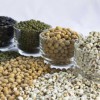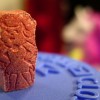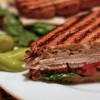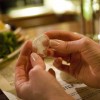 El potasio es un mineral que se encuentra dentro de las células del cuerpo. Es uno de algunos minerales conocidos como electrolitos. Estos minerales (potasio, sodio y cloro) se encuentran en los fluidos dentro y fuera de las células del cuerpo. This 2-page fact sheet is the Spanish language version of Facts about Potassium written by R. Elaine Turner and Linda B. Bobroff, and published by the UF Department of Family Youth and Community Sciences, February 2015.
El potasio es un mineral que se encuentra dentro de las células del cuerpo. Es uno de algunos minerales conocidos como electrolitos. Estos minerales (potasio, sodio y cloro) se encuentran en los fluidos dentro y fuera de las células del cuerpo. This 2-page fact sheet is the Spanish language version of Facts about Potassium written by R. Elaine Turner and Linda B. Bobroff, and published by the UF Department of Family Youth and Community Sciences, February 2015.
http://edis.ifas.ufl.edu/fy1214
Tag: R. Elaine Turner
Facts about Potassium
 Potassium is a mineral found inside body cells. It is one of several minerals known as electrolytes. It is important because it helps regulate fluid and electrolyte balance, maintain normal blood pressure, transmit nerve impulses, control muscle contraction, and maintain healthy bones. Legumes are good sources of potassium, as are nuts and seeds. This 2-page fact sheet was written by R. Elaine Turner and Linda B. Bobroff, and published by the UF Department of Family Youth and Community Sciences, September 2014. (Photo: tofumax/iStock/Thinkstock.com)
Potassium is a mineral found inside body cells. It is one of several minerals known as electrolytes. It is important because it helps regulate fluid and electrolyte balance, maintain normal blood pressure, transmit nerve impulses, control muscle contraction, and maintain healthy bones. Legumes are good sources of potassium, as are nuts and seeds. This 2-page fact sheet was written by R. Elaine Turner and Linda B. Bobroff, and published by the UF Department of Family Youth and Community Sciences, September 2014. (Photo: tofumax/iStock/Thinkstock.com)
http://edis.ifas.ufl.edu/fy889
Datos sobre las vitaminas (FCS8808S/FY1343)
 Las vitaminas son compuestos químicos que el cuerpo utiliza de muchas maneras. Nosotros necesitamos obtener las vitaminas en nuestra dieta porque nuestros cuerpos no las pueden crear. Existen 13 tipos de vitaminas que han sido identificadas como nutrientes importantes para los humanos. This 3-page fact sheet was written by R. Elaine Turner and Wendy J. Dahl, and published by the UF Department of Family Youth and Community Sciences, November 2012.
Las vitaminas son compuestos químicos que el cuerpo utiliza de muchas maneras. Nosotros necesitamos obtener las vitaminas en nuestra dieta porque nuestros cuerpos no las pueden crear. Existen 13 tipos de vitaminas que han sido identificadas como nutrientes importantes para los humanos. This 3-page fact sheet was written by R. Elaine Turner and Wendy J. Dahl, and published by the UF Department of Family Youth and Community Sciences, November 2012.
http://edis.ifas.ufl.edu/fy1343
Datos sobre la niacina (FCS8669S/FY1340)
 La niacina es una de las vitaminas del grupo B (vitamina B3). Nuestro cuerpo necesita la niacina para usar los carbohidratos, las grasas y las proteínas. La niacina también se necesita para reparar el ADN y para el uso normal del calcio en el cuerpo. This 2-page fact sheet was written by R. Elaine Turner y Wendy J. Dahl, and published by the UF Department of Family Youth and Community Sciences, November 2012.
La niacina es una de las vitaminas del grupo B (vitamina B3). Nuestro cuerpo necesita la niacina para usar los carbohidratos, las grasas y las proteínas. La niacina también se necesita para reparar el ADN y para el uso normal del calcio en el cuerpo. This 2-page fact sheet was written by R. Elaine Turner y Wendy J. Dahl, and published by the UF Department of Family Youth and Community Sciences, November 2012.
http://edis.ifas.ufl.edu/fy1340
Facts about Niacin (FCS8669/FY212)
 Niacin is one of the B vitamins (vitamin B3). Our bodies need niacin to use the energy in carbohydrates, fats, and proteins. Niacin also is needed for DNA repair and for the normal use of calcium in the body. This 2-page fact sheet was written by R. Elaine Turner and Wendy J. Dahl, and published by the UF Department of Family Youth and Community Sciences, November 2012.
Niacin is one of the B vitamins (vitamin B3). Our bodies need niacin to use the energy in carbohydrates, fats, and proteins. Niacin also is needed for DNA repair and for the normal use of calcium in the body. This 2-page fact sheet was written by R. Elaine Turner and Wendy J. Dahl, and published by the UF Department of Family Youth and Community Sciences, November 2012.
http://edis.ifas.ufl.edu/fy212
Datos sobre la riboflavina (FCS8668S/FY1344)
 La riboflavina es una de las vitaminas del grupo B. También es conocida como la vitamina B2. Nosotros necesitamos la riboflavina para utilizar los carbohidratos, grasas y proteínas en los alimentos que comemos. La riboflavina ayuda a utilizar estos nutrientes en energía para el cuerpo y para funciones como antioxidante. La riboflavina también se necesita para utilizar correctamente las vitaminas niacina, el ácido fólico y la vitamina B6. This 2-page fact sheet was written by R. Elaine Turner y Wendy J. Dahl, and published by the UF Department of Family Youth and Community Sciences, November 2012.
La riboflavina es una de las vitaminas del grupo B. También es conocida como la vitamina B2. Nosotros necesitamos la riboflavina para utilizar los carbohidratos, grasas y proteínas en los alimentos que comemos. La riboflavina ayuda a utilizar estos nutrientes en energía para el cuerpo y para funciones como antioxidante. La riboflavina también se necesita para utilizar correctamente las vitaminas niacina, el ácido fólico y la vitamina B6. This 2-page fact sheet was written by R. Elaine Turner y Wendy J. Dahl, and published by the UF Department of Family Youth and Community Sciences, November 2012.
http://edis.ifas.ufl.edu/fy1344
Datos sobre los minerales (FCS8809S/FY1341)
 Los minerales son substancias como el calcio, el fósforo, el hierro y el zinc que se encuentran en las rocas y la tierra. También, se necesitan para tener una nutrición adecuada. Hay 16 minerales diferentes que sabemos que son necesarios en nuestra dieta. Varios otros minerales pueden ser necesarios en cantidades pequeñas. This 4-page fact sheet was written by R. Elaine Turner y Wendy J. Dahl, and published by the UF Department of Family Youth and Community Sciences, November 2012.
Los minerales son substancias como el calcio, el fósforo, el hierro y el zinc que se encuentran en las rocas y la tierra. También, se necesitan para tener una nutrición adecuada. Hay 16 minerales diferentes que sabemos que son necesarios en nuestra dieta. Varios otros minerales pueden ser necesarios en cantidades pequeñas. This 4-page fact sheet was written by R. Elaine Turner y Wendy J. Dahl, and published by the UF Department of Family Youth and Community Sciences, November 2012.
http://edis.ifas.ufl.edu/fy1341
Datos sobre la Tiamina (FCS8667S/FY1342)
 La tiamina es una de las vitaminas del grupo B. Es también llamada B1. Nosotros necesitamos tiamina para utilizar los carbohidratos que comemos. La tiamina ayuda a transformar los carbohidratos en energía para el cuerpo. El cuerpo también necesita tiamina para usar algunos de los aminoácidos que componen las proteínas. This 2-page fact sheet was written by R. Elaine Turner y Wendy J. Dahl, and published by the UF Department of Family Youth and Community Sciences, November 2012.
La tiamina es una de las vitaminas del grupo B. Es también llamada B1. Nosotros necesitamos tiamina para utilizar los carbohidratos que comemos. La tiamina ayuda a transformar los carbohidratos en energía para el cuerpo. El cuerpo también necesita tiamina para usar algunos de los aminoácidos que componen las proteínas. This 2-page fact sheet was written by R. Elaine Turner y Wendy J. Dahl, and published by the UF Department of Family Youth and Community Sciences, November 2012.
http://edis.ifas.ufl.edu/fy1342
Enviroshopping for Teens (FCS8756/FY342)
 Every day, we make choices that impact our environment. This 3-page fact sheet will help you make environmentally friendly choices whenever you make purchases and encourage you to take a second look at items before throwing them away. Written by Linda B. Bobroff and R. Elaine Turner, and published by the UF Department of Family Youth and Community Sciences, September 2012.
Every day, we make choices that impact our environment. This 3-page fact sheet will help you make environmentally friendly choices whenever you make purchases and encourage you to take a second look at items before throwing them away. Written by Linda B. Bobroff and R. Elaine Turner, and published by the UF Department of Family Youth and Community Sciences, September 2012.
http://edis.ifas.ufl.edu/fy342
Preparing Healthful Ethnic Foods (FCS8757/FY343)
 Eating a variety of nutrient-rich foods helps you get the nutrients you need to look and feel your best. One tasty way to increase variety in your food choices is to include ethnic foods like Chinese, Mexican, Italian, Greek, and others. How do you know that you are making healthy choices when you eat these foods? This 3-page fact sheet was written by Linda B. Bobroff and R. Elaine Turner, and published by the UF Department of Family Youth and Community Sciences, June 2012.
Eating a variety of nutrient-rich foods helps you get the nutrients you need to look and feel your best. One tasty way to increase variety in your food choices is to include ethnic foods like Chinese, Mexican, Italian, Greek, and others. How do you know that you are making healthy choices when you eat these foods? This 3-page fact sheet was written by Linda B. Bobroff and R. Elaine Turner, and published by the UF Department of Family Youth and Community Sciences, June 2012.
http://edis.ifas.ufl.edu/fy343
Facts about Vitamins (FCS8808/FY890)
 Vitamins are chemical compounds that the body uses in a variety of ways. We need to get vitamins from our diet because we can’t make them in the body. There are 13 different vitamins that have been identified as important nutrients for humans. Learn more in this 3-page fact sheet written by R. Elaine Turner and Wendy J. Dahl, and published by the UF Department of Family Youth and Community Sciences, April 2012.
Vitamins are chemical compounds that the body uses in a variety of ways. We need to get vitamins from our diet because we can’t make them in the body. There are 13 different vitamins that have been identified as important nutrients for humans. Learn more in this 3-page fact sheet written by R. Elaine Turner and Wendy J. Dahl, and published by the UF Department of Family Youth and Community Sciences, April 2012.
http://edis.ifas.ufl.edu/fy890
Facts About Thiamin (FCS8667/FY210)
 A lack of thiamin causes the disease beriberi. People with beriberi have difficulty standing, walking and controlling their muscles. It’s very easy to get enough thiamin in the diet because it’s added to many processed grains. However, people who abuse alcohol or have a very poor diet may suffer from a thiamin deficiency. This 2-page fact sheet was written by R. Elaine Turner and Wendy J. Dahl, and published by the UF Department of Family Youth and Community Sciences, April 2012.
A lack of thiamin causes the disease beriberi. People with beriberi have difficulty standing, walking and controlling their muscles. It’s very easy to get enough thiamin in the diet because it’s added to many processed grains. However, people who abuse alcohol or have a very poor diet may suffer from a thiamin deficiency. This 2-page fact sheet was written by R. Elaine Turner and Wendy J. Dahl, and published by the UF Department of Family Youth and Community Sciences, April 2012.
http://edis.ifas.ufl.edu/fy210
Facts About Riboflavin (FCS8668/FY211)
 Did you know that mushrooms are a good source of riboflavin? Riboflavin is one of the B vitamins, also is known as vitamin B2. We need riboflavin to use the carbohydrates, fats, and proteins in the foods we eat. Riboflavin helps us use these nutrients for energy in our bodies and additionally functions as an antioxidant. Riboflavin also is needed to properly use the vitamins niacin, folate, and vitamin B6. For more facts about riboflavin, check out this 2-page fact sheet written by R. Elaine Turner and Wendy J. Dahl, and published by the UF Department of Family Youth and Community Sciences, April 2012.
Did you know that mushrooms are a good source of riboflavin? Riboflavin is one of the B vitamins, also is known as vitamin B2. We need riboflavin to use the carbohydrates, fats, and proteins in the foods we eat. Riboflavin helps us use these nutrients for energy in our bodies and additionally functions as an antioxidant. Riboflavin also is needed to properly use the vitamins niacin, folate, and vitamin B6. For more facts about riboflavin, check out this 2-page fact sheet written by R. Elaine Turner and Wendy J. Dahl, and published by the UF Department of Family Youth and Community Sciences, April 2012.
http://edis.ifas.ufl.edu/fy211
Facts About Minerals (FCS8809/FY891)
If the word “mineral” makes you think of rocks, you’re right! Minerals are substances like calcium, phosphorus, iron, and zinc that are found in rocks and the soil. They also are needed for optimal nutrition. There are 16 different minerals that are known to be needed in our diets. Several other minerals may be needed in very small amounts. It’s important to eat a variety of foods from each of the food groups in order to get all of the minerals in your diet. This 3-page fact sheet was written by R. Elaine Turner and Wendy J. Dahl, and published by the UF Department of Family Youth and Community Sciences, January 2012.
http://edis.ifas.ufl.edu/fy891
Los hechos acerca de la vitamina K (FCS8666Span/FY940)
 La vitamina K ayuda al cuerpo a hacer las proteínas que se necesitan para la coagulación normal de la sangre. La vitamina K también se necesita para hacer importantes proteínas para los huesos. This 2-page fact sheet is the Spanish language version of Facts about Vitamin K. Written by R. Elaine Turner and Wendy J. Dahl and published by the UF Department of Family Youth and Community Sciences, October 2011.
La vitamina K ayuda al cuerpo a hacer las proteínas que se necesitan para la coagulación normal de la sangre. La vitamina K también se necesita para hacer importantes proteínas para los huesos. This 2-page fact sheet is the Spanish language version of Facts about Vitamin K. Written by R. Elaine Turner and Wendy J. Dahl and published by the UF Department of Family Youth and Community Sciences, October 2011.
http://edis.ifas.ufl.edu/fy940
Los hechos acerca de la fibra (FCS8793SPAN/FY1226)
This 2-page fact sheet is the Spanish-language version of FCS8793/FY849, Facts About Fiber. Written by Jennifer Hillan, R. Elaine Turner, y Wendy J. Dahl , and published by the UF Department of Family Youth and Community Sciences, May 2011.
http://edis.ifas.ufl.edu/fy1226
Datos sobre el potasio (FCS8805Span/FY1214)
El potasio es un mineral que se encuentra dentro de las células del cuerpo. Es uno de algunos minerales conocidos como electrolitos. Estos minerales (potasio, sodio y cloruro) se encuentran en los fluidos dentro y fuera de las células del cuerpo.
This 2-page fact sheet is the Spanish language version of “Facts about Potassium” (FCS8805/FY889) Written by R. Elaine Turner and Linda B. Bobroff. Published by the UF Department of Family Youth and Community Sciences, January 2011.
http://edis.ifas.ufl.edu/fy1214
Facts About Fiber (FCS8793/FY849)
Fiber is a carbohydrate that we cannot digest, found in fruits, vegetables, grains, and beans. Adequate fiber intake can help us maintain good health. This revised 2-page fact sheet answers basic questions about fiber. Written by Jennifer Hillan, R. Elaine Turner, and Wendy J. Dahl. Published by the UF Department of Family Youth and Community Sciences, January 2011.
http://edis.ifas.ufl.edu/fy849
FCS8666/FY209 Facts about Vitamin K
Revised! FCS8666, a 3-page fact sheet by R. Elaine Turner and Wendy J. Dahl, answers common questions about this vitamin found mostly in green vegetables that is needed to make proteins for normal blood clotting. Includes references. Published by the UF Department of Family, Youth, and Community Sciences, October 2010.
http://edis.ifas.ufl.edu/fy209
FCS8669/FY212 Facts about Niacin
Revised! FCS8869, a 2-page illustrated fact sheet by R. Elaine Turner and Wendy J. Dahl, answers questions about this B vitamin. Includes references. Published by the UF Department of Family Youth and Community Sciences, May 2010.
http://edis.ifas.ufl.edu/fy212